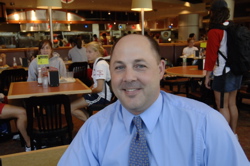Dining Services fights “menu fatigue””

The more than 400 full-time employees of Boston University’s Dining Services aren’t fazed by the idea of cooking 17,000 meals each day, or cleaning up an equal number of place settings. They can handle the culinary needs of carnivores and omnivores and accommodate students celebrating Passover and Ramadan. They can explain the difference between a vegetarian and a vegan. But they just can’t tolerate tedium.
“One of the biggest challenges that we face is boredom, concept fatigue, menu fatigue,” says Josh Hubbard, the director of Dining Services. “So we do a lot of things to try and break up the monotony.”
The efforts to keep meals interesting — which earned BU’s Dining Services an A-plus in the campus guidebook College Prowler — include the Visiting Chef Series, where celebrity chefs from local restaurants come to campus, and “Something Different for Dining,” which might be a carnival-themed meal with cotton candy or a Red Sox celebration featuring hot dogs. The chefs and managers of Aramark, the contract dining services company that has operated Dining Services since 1976, know that students may be tempted by the restaurants along Commonwealth Avenue, and so they’ve developed a simple strategy: treat students as customers and be aware that their business must be earned.
“Restaurants are our competition, and we’re very aware of that,” says Hubbard. “We’re a city school, and we have to keep up.”
Keeping up requires a mix of organization and flexibility. Menus are meticulously planned prior to the start of each semester and operate on a four-week cycle in each dining hall. But when a vendor calls with a special deal on fresh produce or the students have a request, the chefs rely on their training to make large-scale changes quickly and successfully.
Jim Economides, the executive chef at the Fresh Food Company in West Campus, worked at Cambridge’s highly rated East Coast Grill before coming to BU three years ago, and he and his staff are constantly “fine-tuning” the meals. “We look at cookbooks, restaurants, food trends,” he says. “People bring in their own recipes. We’re given a lot of freedom.”
The entertainment component of dining is also considered key to luring students into the dining halls day after day. Special events such as Lobster Night, with its 6,500 lobsters, show students that BU is eager for their business, says Hubbard. The students in turn respond with enthusiasm — when chef Martin Yan of the TV show Yan Can Cook visited campus “it was like a rock star was here,” Hubbard says. “At 9 p.m., 400 students were still waiting to see him.”
Chefs and managers also constantly seek student feedback, whether from the comment cards in every dining hall or conversations held at mealtimes. “I like to challenge managers to come back and tell me the names of five students they have talked to,” says Steve Baldwin, the food services director at the Fresh Food Company. “And we would love for them to come up and talk to us.”
A student advisory committee meets once a month as well to discuss what’s going on in the dining halls and in retail locations around campus — whether the lines at the burrito station are too long or the juices in the machines are too watery. Peter Mayers (CGS’06), a member of last year’s committee, once mentioned that a panini machine would be a nice addition to West Campus. “A week later, voilà !” he says. “I was blown away.”
The interest in student needs is best demonstrated by the University’s response to the burgeoning vegan population. Veganism took off a few years ago, and suddenly a significant number of students were demanding dishes cooked without butter, cheese, or other animal products commonly found in vegetarian foods.
“We took a huge initiative and did five weeks of vegan testing,” says Joe Cacciatore, food services director at Myles Standish. “Every dining hall was in charge of two specific meals. We decided, ‘Let’s not just wing this. Let’s really spearhead it and figure out what they want.’” Now, each dining hall has at least one vegan entrée at every meal.
Like any restaurant, Dining Services periodically receives complaints about quality or quantity, and like any restaurant, takes its reviews seriously. Feedback about the options at Warren Towers, the University’s largest dining hall, have led to a complete redesign of the facility, which has adopted the no-surprises prep technique used in West Campus, where all the food is prepared in full view of students. Concerns about the atmosphere at Myles prompted a summer renovation that includes new floors and new seating. And an increased interest in healthy eating has spawned a collaboration with Sargent College, starting this semester, in which the “Sargent Choice” program offers a balanced meal with nutritional information to help students make healthier choices.
It’s all a part of constant assessment and revision, Hubbard says, to ensure that students’ needs and desires are met. In Aramark’s 29 years at BU, that has meant recruiting chefs from top restaurants, training them to prepare thousands of meals for an intelligent and varied customer base, and learning about the trends and requirements that affect different populations and cultures.
It has also meant that a certain appreciation for the basics never changes — perenially popular choices, Baldwin says, “are French fries, hamburgers, and hot dogs.”